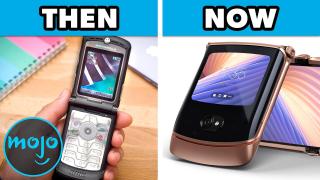Top 10 Failed Cell Phone Designs You Wouldn't Believe

Top 10 Failed Cell Phone Designs You Wouldn’t Believe
Top 20 Toys That FAILED Horribly
Who the heck was the target demographic? Welcome to WatchMojo and today we’ll be counting down our picks for the Top 10 Failed Cell Phone Designs You Wouldn’t Believe. For this list, we’ll be looking at various cell phone and smartphone designs that simply didn’t work - be it in terms of functionality or in terms of marketing. Some were an attempt to mesh phones with other technology, while others sought to revolutionize cellphone design. The one thing they all have common? Missing the mark.
#10: AEsir AE+Y (2011)
We begin our list with a bit of an outlier. Rather than actually innovate, Aesir instead attempted to corner the high end phone market by using super high value materials. But for all that gold, ceramic plating, sapphire crystal and high quality screws… they essentially released a blinged out burner of a phone. We’ll remind you that this came out in 2011, by which point Apple was already onto the iPhone 4S. And yet the AEsir AE + Y didn’t even have the ability to connect to the internet! It looks like the cellphone equivalent of a designer watch, and had a price tag to match with models ranging from $8,000 to $60,000. But despite its appearance, it was an embarrassingly basic phone.
#9: Motorola Rokr E1 (2005)
Motorola Razr Then vs Now
Nothing says “we’re trying too hard” like putting the word “rocker” in the name of your phone. Motorola billed this as their “iTunes Phone” because of its focus on media capabilities. It had iTunes integrated into the phone and, in Motorola’s defense, this was pretty revolutionary given that the Rokr was the first mobile phone to do so. It predated the Apple iphone by two full years! The thing is... the technological leaps between the Rokr and the iPhone felt more like a decade’s worth of difference. The Rokr held a paltry 100 songs, which was laughable compared to dedicated mp3 players. USB 2.0 had been around for years, and yet the Rokr limited media transfers to a painfully slow USB 1.1 technology.
#8: Siemens Xelibri 6 (2003)
Yikes! There’s innovative cellphone design and then there’s this. We’re all for questioning design assumptions in the name of greater efficiency, but this feels like change for the sake of change. Mimicking the shape of a makeup compact, and based on the color scheme, we can see what Siemens was going for with the Xelibri 6; they were clearly attempting to give fashionable women a cellphone that fit their aesthetic and was sure to turn heads whenever they pulled it out. The addition of two mirrors seems fitting, but who wants to dial numbers that have been configured like that? Despite an aggressive marketing campaign, the entire Xelibri line flopped.
#7: BlackBerry Passport (2014)
Poor Blackberry. For those of you who are too young to remember, this smartphone was once synonymous with quality and considered a status symbol. Blackberry was the phone of choice for businessmen and those who needed to get things done. Unfortunately, for the company, touchscreens won the smartphone arms race and became a must-have. Blackberry was forced to innovate or die and sadly… none of their efforts really found the mark.The Blackberry Passport had a touchscreen but also a physical keyboard that also doubled as a touchpad. But the passport-inspired wider shape made it clunky and difficult to carry around, and the screen’s distinct dimensions proved problematic with video and apps. Most damning, the new keyboard was considered a step backwards from earlier blackberries.
#6: Compulab Exeda (2009)
Never even heard of the company, let alone the specific model? You’re not alone in that regard! Compulab is best known for their computers and computer parts - specifically small format industrial PCs. In 2009 however, they attempted to break into the smartphone market with a similarly niche device - the Compulab Exeda. The thing that sets it apart from the competition? An ethernet port. You heard that right! You could plug directly into the internet the old-fashioned way. It also featured an expansion slot, inviting the addition of hardware to suit your specific needs, like you might do with a PC. The problem is that these unique features also make the phone quite bulky. Add to that a high price, and it appeals to only a select few customers.
#5: Nokia 7280 (2005)
Did you think that clamshell phone was bad? Well… the Xelibri 6 ain’t got nothing on this. Shaped like a lipstick tube and reminiscent of some very early mp3 player designs, the Nokia 7280 is more gimmick than functional cellphone. As you may have noticed, one of the biggest game changers that Nokia introduced with this unique design is the lack of keypad. And before you get excited and guess “voice-controlled dialing?!” allow us to jump in and say “no”. You had to enter the numbers using the scroll wheel. You know… like how you used to select songs on your iPod. Except with this phone, you need to slowly dial 6 to 9 numbers that way.
#4: Google’s Project Ara (2013 - 2016)
Top 10 Creepiest Things Found On Google Earth
A phone too strange for this world! No seriously, Google never actually released it. First announced in 2013, Project Ara was a prototype modular smartphone design that asked the question… what if we could upgrade our smartphones rather than replace them? The idea was that you would buy your basic chassis or “frame” and then be able to customize your phone with modular cameras, displays, processors, batteries and a whole slew of peripherals and hardware to make your phone tailor-suited to your needs. It was touted as a way to reduce waste and potentially make quality smartphones more accessible. Originally intended for wide release in 2017, it was instead quietly shelved in 2016.
#3: Sony Ericsson Xperia PLAY (2011)
If one company was well positioned to bridge the gap between smartphones and gaming before all others, it was Sony. With the success of their various Playstation consoles (both stationary and handheld) and their experience across the spectrum of tech, they had this in the bag. The Sony Ericsson Xperia PLAY was advertised as a PS Vita and a smartphone all wrapped into one sleek package. And it accomplished this with a full gamepad that slid out from behind the screen. Unfortunately, its hardware was just too restrictive. It couldn’t make the leap to Android 4.0, and that effectively rendered this once promising and novel smartphone utterly obsolete. Of course, a lack of stable gameplay didn’t help.
#2: TOSHIBA G450 (2008)
Is that a portable speaker? Some sort of electronic memory game the ‘90s? Nope… it’s a cellphone that Toshiba released in 2008! Just as a refresher, the first iPhone hit the market in 2007. Who Toshiba thought would opt for this little gizmo instead, we have no idea, but they made it! The G450 was intended as a hybrid cell phone, mp3 player and portable modem. Translation? Too many things at once. The design was simply too odd for anyone to ever really master. Each button served a wide variety of potential functions depending on what menu you were navigating at the time. In short, it was far more headache than its functionality was worth. Before we unveil our top pick, here are a few honorable mentions. Samsung Galaxy Beam (2012) Asus PadFone (2012) Bang & Olufsen Serene (2005) Motorola Flipout (2010) Nokia 7600 (2003)
#1: Nokia N-Gage (2003)
We’ve got to hand it to Nokia; no one could accuse them of playing it safe! In the aughts, they seemingly had a “no such thing as bad ideas” approach to cell phone design. But of all their inefficient designs, this one reigns supreme. Released in 2003, it was similar to Nintendo’s Game Boy Advanced (released in 2001) in terms of its shape and grip. It also attempted to take a bite out of Nintendo’s sales by having the phone double as a portable gaming console. With only a handful of launch titles, however, it simply couldn’t compete. It’s shape also earned it the unflattering nickname “taco phone”. Add to that its many design flaws and a steep price tag, and it was a flop by all metrics.




